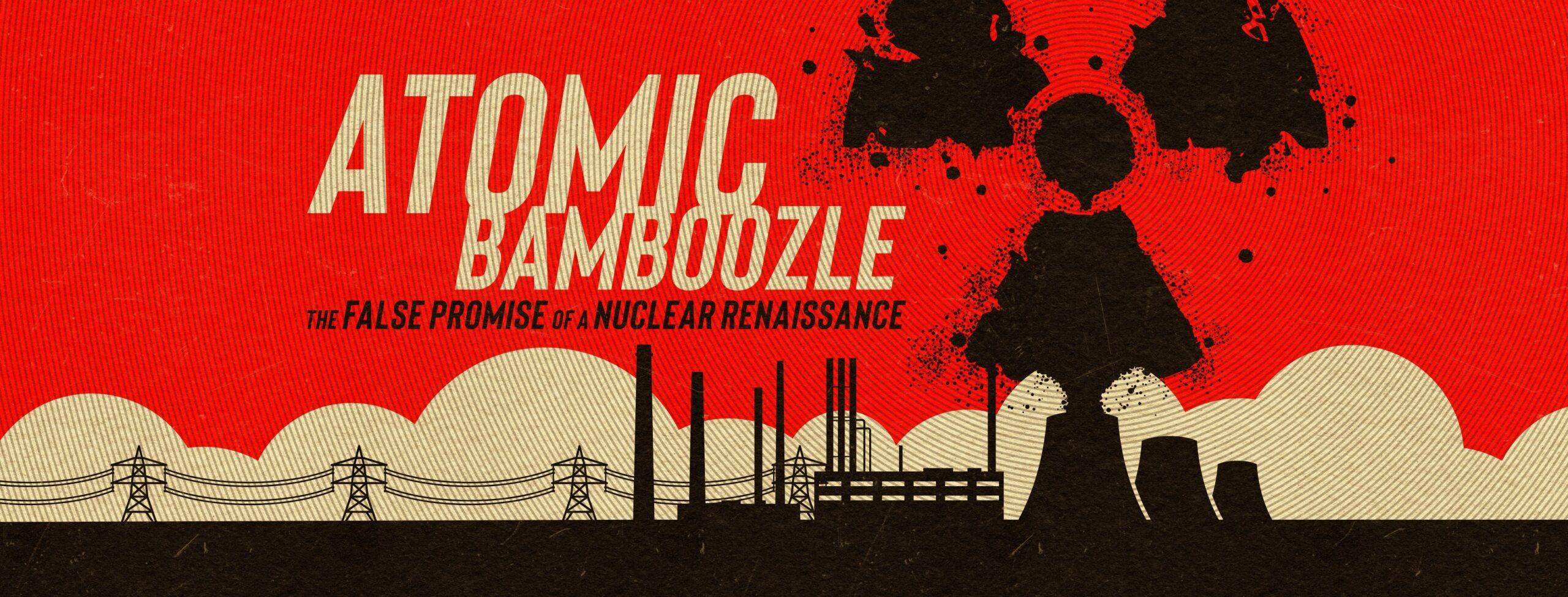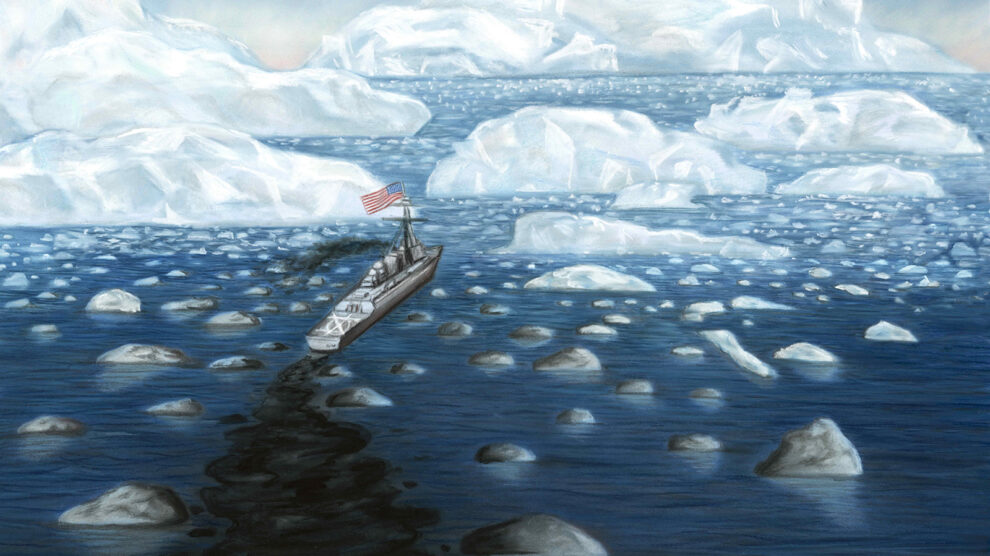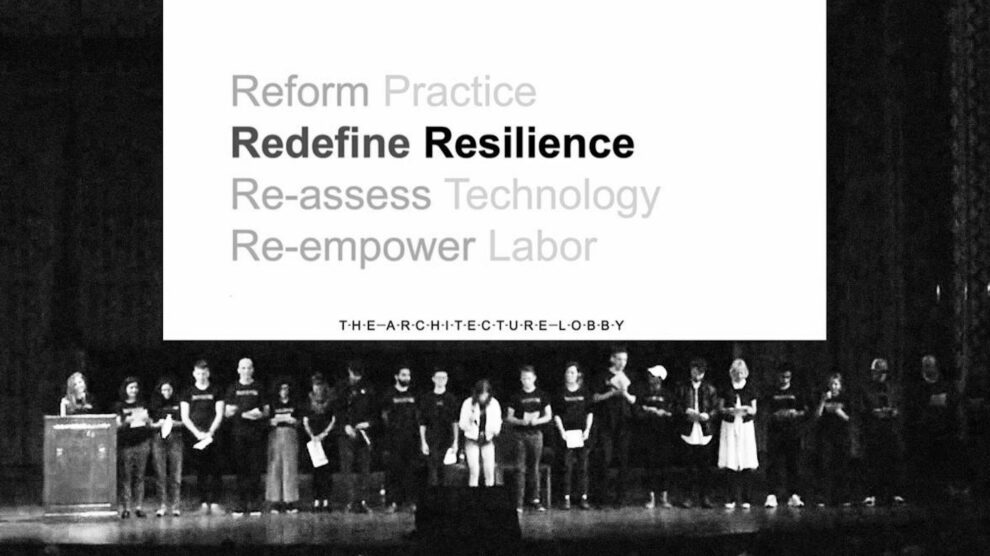December 29, 2023
Here We Go Again: Yet Another “Nuclear Renaissance”
By Cliff Conner
Nuclear Now, a documentary film by Oliver Stone, written by Oliver Stone and Joshua S. Goldstein. Running time: 1 hour and 45 minutes. Adapted from a book: A Bright Future: How Some Countries Have Solved Climate Change and the Rest Can Follow, by Joshua S. Goldstein and Staffan A. Qvist.
Atomic Bamboozle: The False Promise of a Nuclear Renaissance, a documentary film by Jan Haaken. Running time: 46 minutes.
Nuclear power made its first dramatic appearance on the stage of history with the Trinity atomic bomb test in July 1945. Less than a month later it was used to obliterate two Japanese cities and hundreds of thousands of their inhabitants, and it has ever since been a fearsome sword of Damocles hanging over the heads of all humanity. The proposal of an international “Atoms for Peace” program in late 1953, however, initiated the prospect of a civilian use of atomic energy that would be enormously beneficial to humankind rather than an existential threat.
While many people did not question the promise of nuclear power as a potential source of unlimited clean, safe, inexpensive energy, many others were skeptical, and warned that its safety was unproven and could not be merely assumed. A public debate ensued, the result of which was a grass-roots antinuclear movement of massive proportions that succeeded in imposing sharp limitations on the size and spread of the nuclear power industry.1 The movement’s warnings were vindicated by a number of nuclear disasters and near-disasters, most notably the meltdown and massive escape of deadly radiation at a nuclear plant in Chernobyl, Ukraine.
Meanwhile, the privatized, heavily subsidized nuclear energy industry had built and was operating dozens of electricity-generating plants driven by nuclear reactors throughout the United States and in a number of other countries. In the wake of a frightening meltdown at Three Mile Island in Pennsylvania (1979) and the subsequent catastrophe at Chernobyl (1986), the nuclear industry encountered massive public pushback and went into eclipse. Although never shutting down entirely, its energy-producing capacity was significantly curtailed.
Investors who had put their money into nuclear energy were loathe to simply write off those highly profitable investments, and kept up a massive public relations and lobbying effort to convince public opinion of the safety and “cleanliness” of their product. The opposition to nuclear energy, over time, waned and the nuclear industry began to recover its lost ground.
Its comeback, however, was cut short by another massive accidental escape of radiation in 2011 at a nuclear power plant in Fukushima, Japan, and once again the international nuclear energy industry went into a tailspin. Germany closed down eight of its oldest reactors and promised to phase out all of them; its last three nuclear power plants were shut down in April 2023. Switzerland pledged to do the same by 2034.
In the United States, the industry had already been in decline for economic reasons; the Fukushima disaster accelerated that trend. It has remained in the doldrums until recently, when signs of a new “renaissance” have appeared in the form of a major PR and lobbying campaign promoting an innovative technology known by its initials, SMR—Small Modular Reactors. The antinuclear movement has begun to shake off its complacency and push back, declaring that SMRs are nothing more than the same old nuclear technology operating on a tiny scale. They can be expected to produce more radioactive waste per megawatt hour than large reactors. The industry’s claim that SMRs will be more economically viable is especially ludicrous, because their only innovation deprives them of economies of scale.
Is nuclear energy THE ANSWER to saving the Earth from ecocide by fossil fuels? That is the question.
Unlike the false debate between climate scientists and climate-deniers, the dispute over nuclear power derives from a genuine problem that cannot be ignored—the fossil-fuel-driven climate crisis. The proposal of nuclear power as the antidote to an existential danger is serious and worthy of thoughtful consideration. Is nuclear energy THE ANSWER to saving the Earth from ecocide by fossil fuels? That is the question. Two advocacy documentary films, Nuclear Now and Atomic Bamboozle, represent the opposing sides of this debate.
Nuclear Now is an entertaining and powerful documentary with a seductive argument in support of atomic power as an alternative to fossil fuels. Its director, Oliver Stone, enjoys a reputation as a talented filmmaker and political polemicist. Atomic Bamboozle, by contrast, argues that the dangers inherent in atomic energy production make it unacceptable as a solution to the climate catastrophe. It is an out-of-the-frying-pan-into-the-fire option.
“Making Nuclear Energy Cool Again”
Atomic Bamboozle opens with a scene in which Department of Energy Secretary Rick Perry introduces a coterie of about a dozen bright and eager young people with these words:
This group of young men and women are the millennials for nuclear power. This is the brain trust. They are going to make nuclear energy cool again.
That statement neatly epitomizes what the nuclear power industry aims to accomplish with its current pro-nuclear campaign and how they intend to achieve it. By appealing to the youthful energy of environmental activists whose fear of global warming outweighs concerns about the dangers of nuclear power, they hope to create a groundswell of public opinion that will open the way to a new generation of nuclear reactors. Rick Perry’s presence in the scene demonstrates the governmental collaboration in the pro-nuclear campaign.
Nuclear Now uses a familiar debater’s ploy by importing the desired conclusion into the terms of the debate itself. The film repeatedly uses the term “clean energy” as a synonym for “nuclear energy,” but if nuclear energy is unambiguously “clean,” then the debate is over and nuclear energy is indeed the solution to the climate crisis.
The cleanliness of nuclear energy, however, refers only to the fact that, unlike fossil fuels, it does not add greenhouse gases such as carbon dioxide or methane to the Earth’s atmosphere. That is a powerful argument in its favor, but unfortunately, nuclear reactors introduce another highly undesirable pollutant into the environment: ionizing radiation that poses a severe threat to human (and nonhuman) health. The antinuclear movement has long insisted that the radiation danger makes nuclear power the dirtiest of all energy sources. Ionizing radiation enters the food chain, exposing organisms that eat the food to harmful genetic mutations that are then passed on from generation to generation ad infinitum.
The Nuclear Waste Crisis
The radiation danger is twofold; not only from the possibility of catastrophic releases into the atmosphere, but also from the routine day-to-day operations of nuclear plants producing nuclear waste that irradiates the soil and groundwater.2
Nuclear Now resolutely downplays the problem of nuclear waste. Oliver Stone was quoted in an interview as saying that nuclear waste is “not an issue” and is “completely handleable.”3 That is a bold assertion that many concerned and knowledgeable people strongly dispute. His film deals with it by showing some impressive high-tech spent-fuel storage facilities, but those are showcase examples that misdirect attention away from what is in fact a real crisis of nuclear waste storage. In Atomic Bamboozle, environmentalist attorney Lauren Goldberg accurately warns that “the nuclear power industry in the United States has yet to solve the ultimate puzzle, which is what to do with nuclear waste.”
The radioactive waste problem has long been out of control In the United States. In 1982, more than four decades ago, the Congressional Quarterly reported that a solution was then already almost four decades overdue:
Although there had long been broad general agreement on the need for legislation to establish a comprehensive national policy for the disposal of highly radioactive nuclear waste, no such legislation had been enacted during the nearly 40 years that nuclear waste had been generated in the United States.4
In 2002 the U.S. Congress finally approved a plan to build a national nuclear waste repository at Yucca Mountain, Nevada. The state of Nevada, however, objected to being the national nuclear dumping ground, so the project went into limbo. As of December 2023, the Environmental Protection Agency reports, “The future of the Yucca Mountain repository is uncertain.”5 Meanwhile, more than eighty thousand tons of spent fuel will presumably continue to be stored in pools or dry steel-and-concrete casks at a hundred or so separate sites across the country—the ones that had been running out of space in 1982, and that had never been designed for long-term storage in the first place.
Science controlled by commercial interests is inherently untrustworthy.
Nuclear Now selectively cites scientific research, much of it produced or financed by the nuclear industry, to downplay the waste disposal problem and to suggest that Small Modular Reactors pose no serious risk of radiation leakage. These claims cannot be taken at face value because science controlled by commercial interests is inherently untrustworthy.
The Antinuclear Movement and the Public’s Fears
Nuclear Now disingenuously attributes the public’s widespread distrust of nuclear power to “disinformation” and fear-mongering on the part of the antinuclear movement. It also demagogically implies that the antinuclear movement depends upon the financial backing of the fossil fuels industries. That implication is false. The overlap among the investors in fossil fuels and nuclear power is extensive. As physicist and environmentalist M.V. Ramana explains in Atomic Bamboozle:
Every utility in the United States that owns a nuclear plant also owns fossil fuel assets. It could be coal, it could be oil, it could be natural gas, or some combination of all of them. None of them want to see very rapid climate action because then that would mean they’d have to shut down a whole bunch of fossil fuel plants. So they want to pretend that they’re interested in solving the problem while also maintaining their current sources of wealth.
The antinuclear movement arose as a genuine grassroots movement not unlike the Civil Rights and anti–Vietnam War movements. It mobilized millions of people to demand that unsafe nuclear plants be shut down, and it partially succeeded. However, also like the antiwar and Civil Rights movements, its hard-won victories were not final. The struggles against war and racism continue. The “renaissance” of the pronuclear interests portrayed in Nuclear Now and Atomic Bamboozle demonstrates that the antinuclear struggle continues, too.
Civilian and Military Nuclear Energy Are Joined at the Hip
Another widespread public fear is proliferation of nuclear weapons. Nuclear Now downplays that highly rational fear by minimizing the intimate links connecting the commercial nuclear industry with the military-industrial complex. In Atomic Bamboozle, however, physicist M.V. Ramana reminds us, “All nuclear reactors produce plutonium. Many of these use enriched uranium. The same technology that can enrich uranium, so-called centrifuges, can also make uranium that’s enriched enough to be used to make weapons.”
“Atoms for Peace” was from the beginning a cover for the U.S. military’s creation of an immense nuclear arsenal. The pretense of their separateness is belied by U.S. policymakers’ insistence that the civilian nuclear programs of North Korea and Iran cannot be separated from their military programs. The immense governmental subsidies for the U.S. nuclear power industry are still driven by the military’s desire to disguise its secretive nuclear operations as “atoms for peace” as much as possible.
Nuclear Now’s frequent statements about “the use of this energy for the benefit of society” are naive and ultimately beside the point. Neither the military nor the civilian branches of the nuclear industry are driven by concern for how they “benefit society.” The commercial nuclear industry is motivated, like all of corporate America, by a quest for profits. And that is complicated by the fact that their profitability has historically been entirely dependent upon massive government subsidies. This particular example of governmental largesse is rarely acknowledged in the public discourse for the same reason that military spending in general is deemed sacrosanct.
Factoring in those subsidies reveals the emptiness of the happy business chatter at the end of Nuclear Now that simply assumes the new SMR technology can make the nuclear industry economically viable. (This is a key consideration in a society in which an industry must be profitable to exist. A society that prioritizes human needs over corporate profits would pay whatever costs are necessary to avoid a terminal planetary climate catastrophe.)
The civilian nuclear industry has never been financially self-sustaining and is highly unlikely to ever be. For one thing, if commercial nuclear power plants had to pay the costs of their nuclear waste storage themselves, they would find profitability an impossible dream. For another thing, if they had to finance their own insurance risk, they simply could not survive. Without enormous government subsidies and legislation limiting its liability for catastrophic accidents, the industry would be unable to function.6
There Is No Technological Fix for the Climate Crisis
The most general flaw in the nuclear renaissance propaganda is that it reduces a political and economic problem to an engineering problem. A solution to the global climate crisis will certainly include technology inputs, but no “technological fix” can solve the problem in the absence of fundamental societal change. The solution requires getting rid of fossil fuels entirely, and that will not happen simply by making a technological alternative available. The oil, coal, and gas industries are trillion-dollar industries. The investors who own them will not simply walk away from trillions of dollars of their wealth.
Solving the global climate crisis will require an all-out Manhattan Project–type effort on a global scale. And that will require the advent of governments that prioritize solving it above the profit interests of the corporate entities that now control them. As M.V. Ramana says, in summarizing the conclusion of Atomic Bamboozle, “We have to change the system fundamentally. By the system, I mean our social system, our economic system, the way we produce things.”
Cliff Conner is the author of The Tragedy of American Science: From the Cold War to the Forever Wars and A People’s History of Science. He taught history of science at the School of Professional Studies at the City University of New York Graduate Center.
- The largest antinuclear demonstration in U.S. history took place on June 12, 1982 in New York City. See: https://www.armscontrol.org/blog/2018-06-10/fight-continues-reflections-june-12-1982-rally-nuclear-disarmament
- In addition to the radioactive waste produced by nuclear reactors is the waste produced by uranium mining. See EPA.gov, Radioactive Waste From Uranium Mining and Milling: “In the past, the waste rock produced by underground and open pit mining was piled up outside the mine. This practice has caused problems, including on Navajo lands where more than half of the small, abandoned uranium mines from the middle of the 20th century and their wastes remain. Wind can blow radioactive dust from the wastes into populated areas and the wastes can contaminate surface water used for drinking. Some sites also have considerable groundwater contamination.”
- “Oliver Stone says nuclear power is ‘the only option’ for society,” Independent, May 2, 2023.
- Congressional Quarterly, “Comprehensive Nuclear Waste Plan Enacted,” 1982.
- Environmental Protection Agency, “Frequent Questions: Radioactive Waste,” epa.gov, last updated December 8, 2023: https://www.epa.gov/radiation/frequent-questions-radioactive-waste#yucca-mountain
- See: Taxpayers for Common Sense, “Understanding Nuclear Subsidies—In Brief,” March 21, 2021; and US Nuclear Regulatory Commission, “Backgrounder on Nuclear Insurance and Disaster Relief,” last updated April 11, 2022






